LAST UPDATED DECEMBER 10, 2024
The most famous tone-deaf statement
“Let them eat cake,” cried a woefully oblivious Marie Antoinette.

This was her supposed response to hearing that the French peasants were starving because they had no bread. But, while bread was a basic staple, the cake she allegedly suggested as an alternative was a luxury no peasant could afford.
As it transpired, there was no evidence she actually said these words. But it remains one of the most famous tone-deaf statements never uttered.
Fast forward to 2020
The Covid-19 pandemic was a particularly tricky time for brands, with so many examples of brands putting out messages that completely missed the mark.
And some of these brands were called tone-deaf.
But what is tone-deaf messaging, why is it such a problem and how can we avoid it in our communications?
What is tone-deaf messaging?
Tone-deaf messaging is so called because the tone of the message suggests the brand isn’t listening. They’re failing to read the mood in the room or acknowledge how their audience might be feeling at the time.
Consequently, their message can come across as uninformed, insensitive and even offensive, to those they’re trying to communicate with.
Around the time of the Covid-19 lockdowns, I saw lots of angry posts from people who’d received marketing emails advertising luxury resorts, swimwear and luggage. All at a time when their much-anticipated holidays had already been cancelled. Ouch!
But brands would never purposely upset their customers, would they?
How do they get it so wrong?
In the case of the holiday marketing, it seems the emails were written and scheduled in advance. So they’d been forgotten about until they started appearing in customers’ inboxes.
But in other examples, the tone and timing of these messages can simply be overlooked. And the glaring issues only become obvious when people start pointing them out on social media.
Misjudged messages
Take the Dettol ad, below left. It was part of a campaign displayed on the London Underground and was meant to make us feel pumped about going back to work. But it was understandably misjudged. The below right image, was created in response and summed up how a lot of people were actually feeling about returning to work.
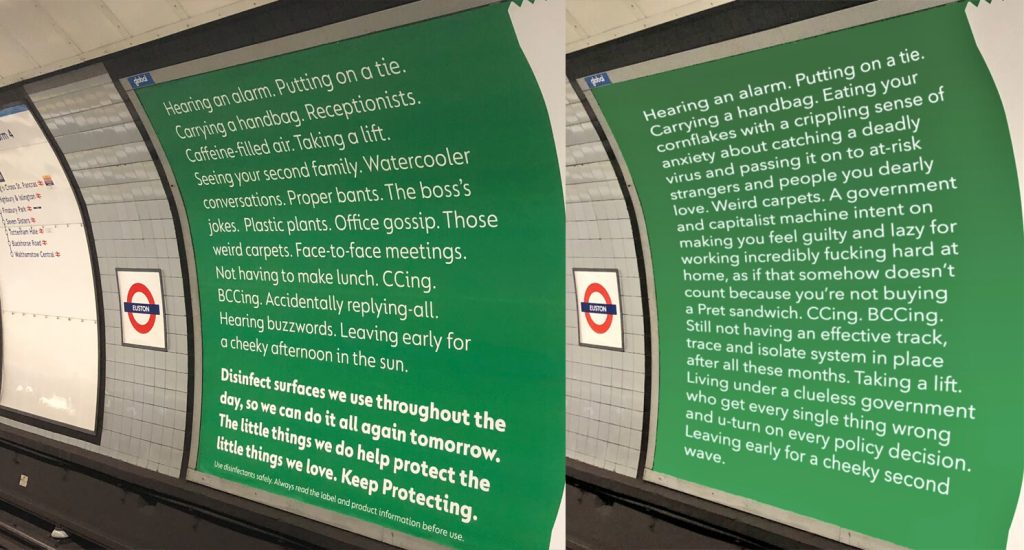
These ads appeared as the government was urging people to get back to their offices and workplaces, after spending months working from home. So when only the text portion of it was shared, it looked like government-sponsored tone-deaf messaging.
Below is another ad from the same campaign. This one expects us to be psyched about getting back to using the Tube again every day. And it shows the full version of the ads, with the Dettol image included.
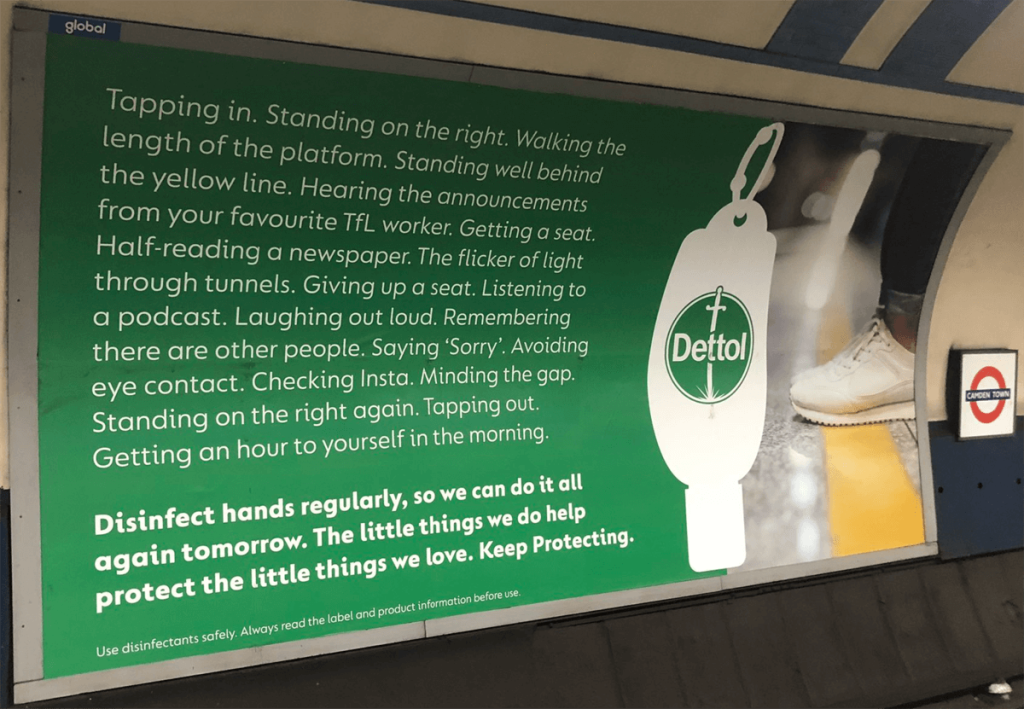
As it turned out, people weren’t that excited about getting back to work — and especially not for any of the reasons pointed out in the ads.
Many had enjoyed working from home. They’d saved themselves time, money and stress by not commuting. And they’d found themselves less distracted, more productive and more satisfied by their work.
Some were apprehensive about mixing again. And others were dreading returning to toxic workplaces where they’d faced bullying or harassment.
Dettol’s ads got a lot of attention, but for all the wrong reasons. It hadn’t been listening to its audience and its message was way off the mark.
Tone-deaf messages like these can make your brand look unaware, uninformed and wilfully ignorant. So how can you avoid making the same mistakes?
Here are 10 tips to show your audience you’re listening and keep your communications on the right track.
10 ways to avoid tone-deaf messaging
1. Check what’s scheduled
Some businesses schedule their social media posts and marketing emails weeks and months ahead — then forget about them.
This is why some companies were still promoting holidays and luggage sets when the lockdowns started.
It’s also why Ticketmaster angered Motorhead fans by advertising that the band — including their frontman, Lemmy — would be appearing at the 2016 Download Festival. When, in fact, Lemmy had died at the end of 2015.
If you’re scheduling ahead, don’t lose sight of what your putting out there. Make it part of your routine to check your scheduled content and give yourself enough time to re-evaluate/rewrite it if you need to.
This should include any social media hashtags you might have included, as these can take on new meanings as other events and campaigns unfold.
2. Pay attention to current issues
Keep up with the news to make sure you know what’s going on in the world. And be aware of how your messages might be perceived in relation to current issues and events.
For example, dropping a new product with a “BOOM!” could seem insensitive if it happens to coincide with reports of a catastrophic explosion.
Use trending topics and hashtags with care
Spontaneously jumping on trending topics and hashtags can be a great opportunity to draw attention to your brand. But make sure you understand what they mean first.
Take this shared tweet from DiGiorno Pizza, for example. They jumped on the #WhyIStayed hashtag to promote their pizza. But they hadn’t realised it was actually being used to share stories about domestic violence.
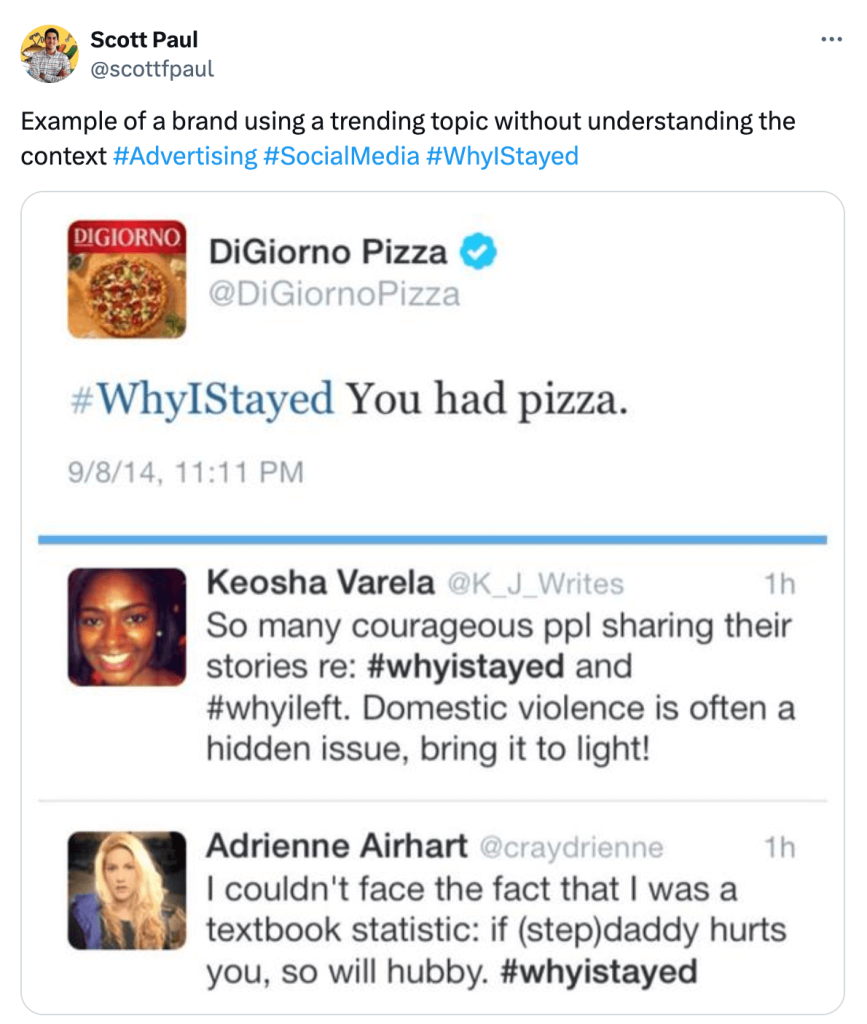
3. Listen and learn
Listening to and learning from those around you can help you read the room and open your eyes to issues you might not have been aware of.
Listen to your audience
What are they talking about and how are they responding to current issues and events?
You can learn a lot about how people think by reading online posts and comments.
If you’re wondering where to look, try:
- Comments sections on relevant online newspaper stories
- Relevant forum posts and responses
- X threads, posts and trending topics
- Searching social media for specific topics and themes.
This will help you identify and be aware of any potentially contentious issues.
If Dettol had done this before working on the concepts for their London Underground campaign, they might have gone in a completely different direction.
Listen to your colleagues
When developing concepts, ask for input and opinions. Not just from inside your creative department, but from other colleagues, too. People who are not connected to, or involved in, the project can give valuable and objective insight — and they might see things you’ve missed.
If Avanti West Coast had actually talked to their menopausal colleagues they might have thought twice before handing out this incredibly insensitive and insulting ‘menopause pack’.
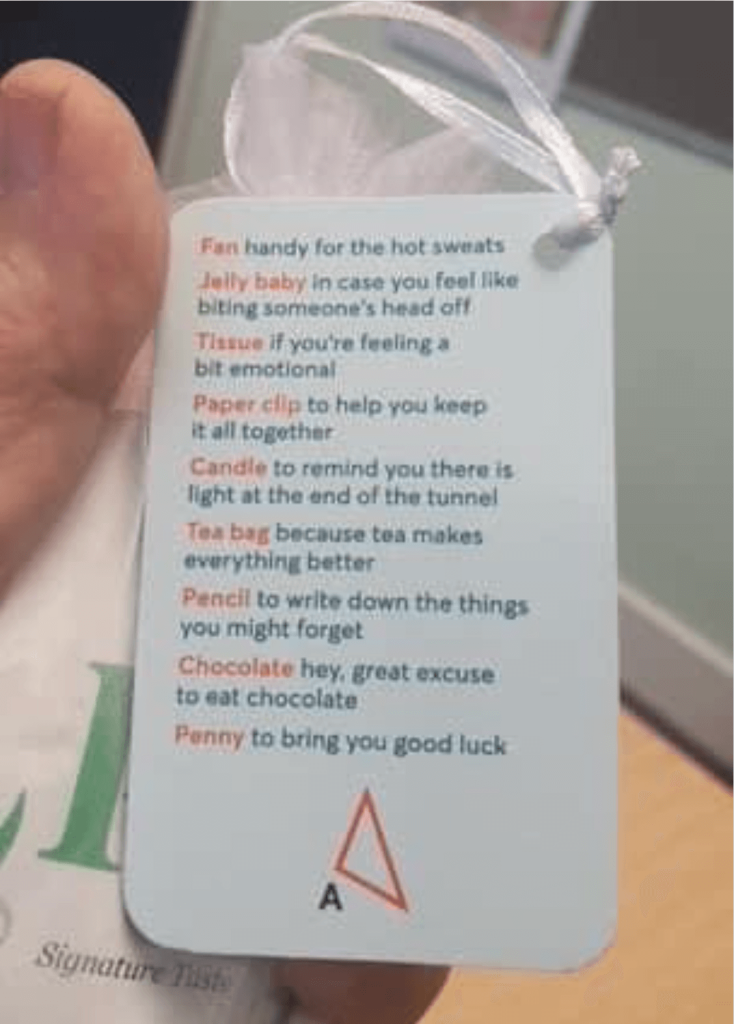
Learn from the mistakes of other brands
Brands get things wrong all the time. Like weighing in on discussions that don’t concern them and ‘celebrating’ traditionally disadvantaged groups, while simultaneously putting them down.
Like this Bic advert, for example, that was created to celebrate Women’s Day in South Africa.
The whole advert was distasteful, but the ‘Think like a man’ line was particularly problematic.
And, once they’re online, these things don’t disappear. This Bic ad was from 2015 and you can still find it everywhere.
4. Check your advantage
While some lives are charmed and burgeoning with opportunity, others are not so lucky. This was particularly evident during the Covid-19 pandemic.
As some celebrities were complaining that they couldn’t get their hair styled, botox injections or lip fillers during lockdown, their followers were dealing with more serious problems, like redundancy and money worries.
And while some businesses were boasting about their busiest months on social media, their competitors were hitting the rocks.
We’re not all in the same boat
The banks were bailed out by the taxpayers in 2008, but it seems they weren’t so giving when the situation was reversed. Customers found NatWest’s pandemic messaging very ‘we’re all in this together’, but this sentiment wasn’t shared by those who were genuinely struggling to keep roofs over their heads. And the offer of ‘a little extra help’, with a token-gesture overdraft extension, felt ignorant of these real and devastating problems.
As people eloquently pointed out, we were not all in the same boat during the pandemic. We were all in the same storm, but in very different boats. Some in luxury cruise ships and some in leaky rowing boats.
If you’re in an advantaged position, that’s obviously not a bad thing. But you need to be aware of how that advantage can alter your perception of some things and blind you to others.
5. See the people, not the pound-signs
Some brands don’t see their customers as people, but as walking bags of money, just ready to be exploited.
And these brands:
- Hound them about things they expressed a vague interest in
- Follow them around the internet with targeted ads
- Disrespect them with passive aggressive messages
- Spam them with unsolicited emails — even under GDPR
- Prey on their worries and insecurities.
Remember, everyone you’re talking to is a person — and they’re all dealing with their own difficulties and challenges.
If you’re persistently needling those who are not responding the way you want them to, you’re not reading the signs properly and you need to change your approach.
A more successful strategy would be to stop focusing on making money and, instead, see how you can help. Because helping is always more welcome than selling.
6. Know who you’re talking to
Following on from point 5, don’t stop at seeing people as people — be proactive and thoughtful in the way you communicate with them. You can do this by getting to know and understand your audience.
This was something Rude Health failed to take into account when they posted this pro-dairy message on Instagram back in 2017.

Rude Health is an alternative milk brand specialising in non-dairy varieties. And while its target market includes those who are lactose intolerant, the larger proportion are vegan — and they were outraged by this seemingly uninformed, pro-dairy post.
Thoughtful marketing
Knowing your audience can help you avoid faux-pas like these and be proactively thoughtful instead.
Letterbox flowers company, Bloom & Wild, was a pioneer of the thoughtful marketing approach. One of their thoughtful marketing gestures was giving customers the choice to opt out of marketing communications that might be sensitive for them. For example, like those who had lost their mothers and wanted to avoid the Mother’s Day marketing.
Another good example is Macmillan, the UK cancer support charity. They use people-first language and talk about “people with cancer” rather than “cancer patients”. You can read their tone of voice guidelines online.
The rules on using people-first language
People-first language puts the person before their medical condition or disability. So ‘a diabetic’ would become ‘a person with diabetes’.
This might seem to be a good blanket rule for talking about those with disabilities and other conditions — but it isn’t. In these cases you should always be advised by the people you’re talking about.
For example, many disabled people prefer to be referred to as ‘a disabled person’ rather than ‘a person with a disability’. And many autistic people like to be referred to as ‘autistic’ rather than ‘a person with autism’.
People who’ve explained this say it’s because their disability or condition is such a huge part of who they are and something that affects every part of their life experience.
Ignoring the wishes of the people you’re talking about — and thinking you know better — will just come across as arrogant, inconsiderate and tone-deaf.
7. Use humour with caution
People like to laugh and be entertained. A study by Clutch, a leading US research firm, showed that 53% of consumers are ‘most likely to remember and enjoy an advertisement if it’s funny.’
But using humour in your brand communications can also be risky, for a number of reasons.
Humour is subjective
Not everyone finds the same things funny. If people don’t get the joke, they may feel silly or excluded.
Who or what is the butt of the joke?
Does your humorous message ridicule another company, person or group?
Maybe it’s a cheap dig at your competitors. A message of commiseration for those who don’t buy your products. Or your ‘humorous’ take on someone else’s content.
You need to think about how this kind of humour might be perceived by your target audience. Will they get the reference? Will they actually think it’s funny? Or will they see it as petty, mean or in poor taste?
Remember, the goal is to entertain them and make them laugh. If you’re not sure you’re going to achieve that, is it worth taking the risk?
Is it on-brand?
Does being funny make sense for your brand?
Not all brands have to be funny. If your communications are usually serious and businesslike, using humour could seem unexpected and out of character.
What if it falls flat?
Trying to be funny and failing is always worse than not trying to be funny at all. And people often remember your failures more than your successes.
So if you’re not confident about using humour, maybe it’s best not to.
8. Be socially and culturally aware
Social and cultural blunders are all too common.
Brands sometimes make botched attempts at being inclusive, like this widely condemned Dove advert, in which a black woman changes to a white woman.
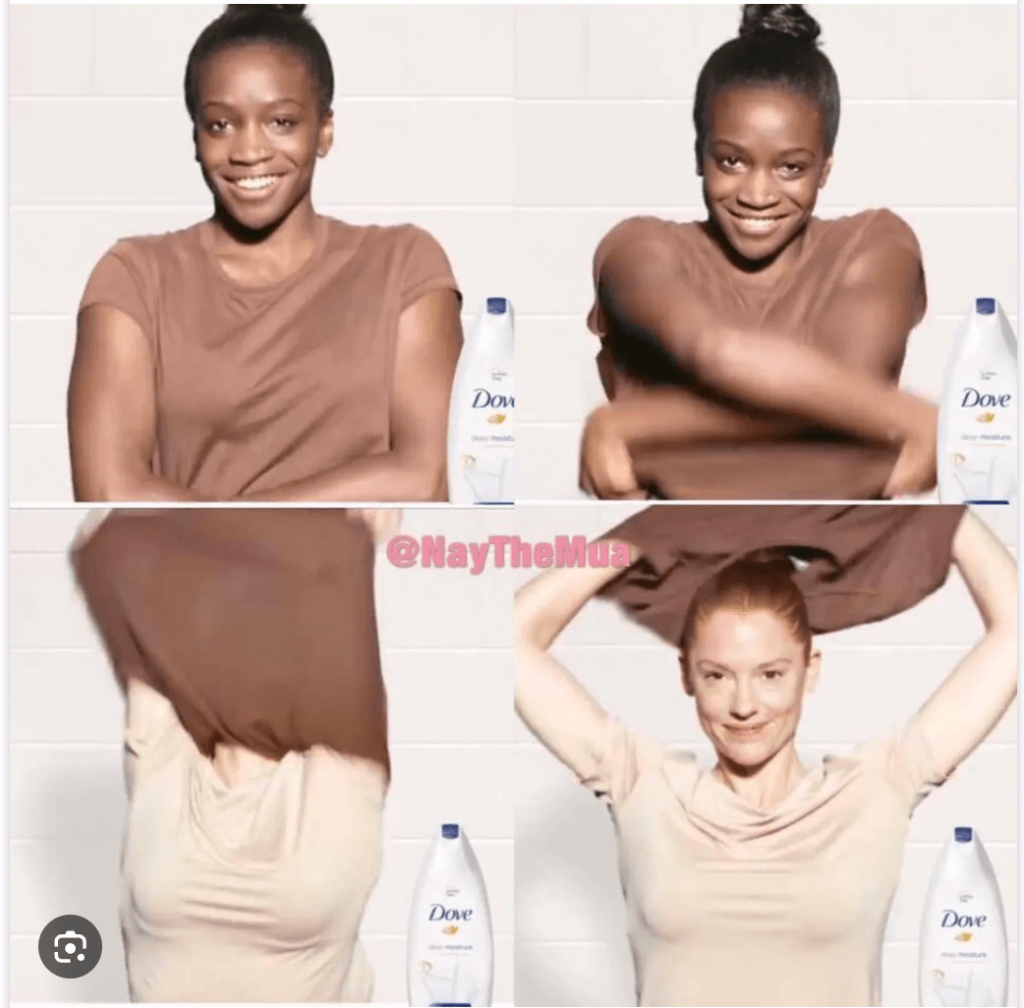
Or they use language that divides opinion. Like the language on Superdrug’s Luna pads pack, which used the phrase ‘a person who menstruates’ rather than ‘a woman’.
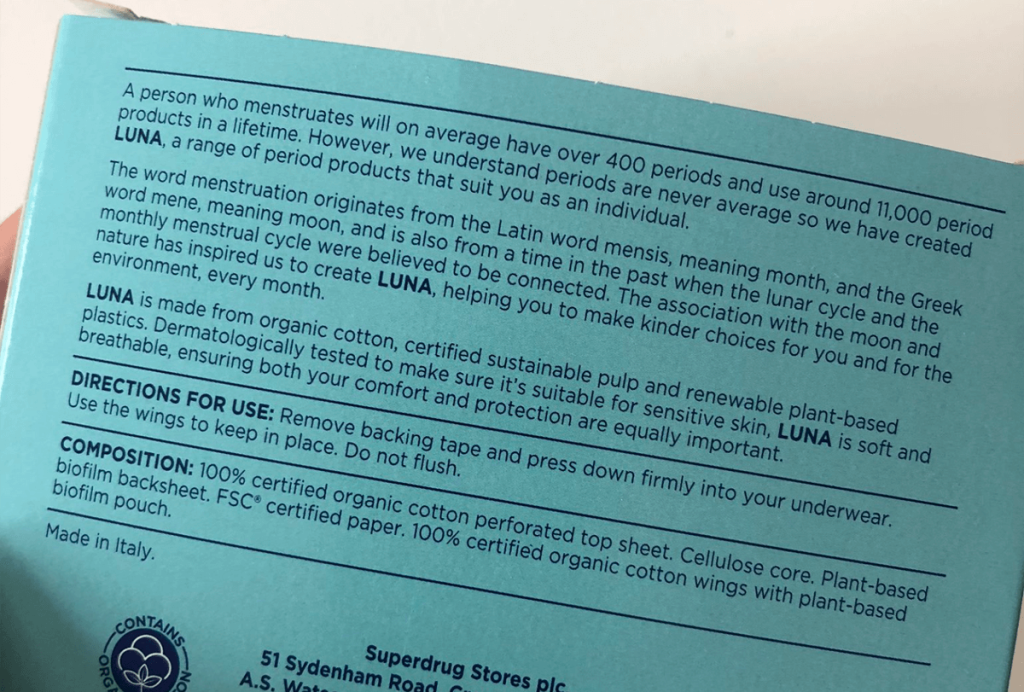
At the time, this was a bold and deliberate proclamation of inclusivity and was welcomed by LGBTQ supporters.
But it caused many women — the largest section of their market by far — to say they felt they were being erased. And, from the responses on Twitter, it seemed like a serious misstep that would cost Superdrug valuable customers.
If they’d used customer-focused messaging and talked to the buyer as ‘you’, rather than using the third person, it would have sounded more natural and been inclusive to everyone. But it seemed they deliberately chose not to, so they could make a point instead.
Being more socially and culturally aware comes back to listening, understanding the challenges your customers are facing.
9. Choose your causes wisely
Most brands have principles they stand for and causes they support. And both the cause and the brand can benefit from the publicity this creates.
You might think supporting lots of causes and getting lots of publicity would be good for a brand, but it doesn’t tend to work out that way. Because brands that try to stand for everything often end up looking confused and desperate for attention.
Worse still, when they pledge their support for these causes, it often seems spur of the moment and without the necessary context, awareness or understanding. And this can lead to tone-deaf messaging.
When it comes to causes, it’s much better to stand for one or two causes that you truly believe in and that really mean something to you. These should be causes you’re completely familiar with and where you can use your voice and actions to make a meaningful difference.
10. Put your brand first
When you’ve spent time and effort building a brand, the last thing you want to do is jeopardise all your hard work with a spontaneous, tone-deaf message.
Tone-deaf messaging is never purposeful, but it has the capacity to:
- Make you look oblivious, uninformed and unaware
- Anger or offend lots of people
- Alienate your core audience.
To avoid falling into problems and risking everything you’ve worked so hard to build:
- Separate your personal feelings from your brand
- Be clear about what your brand is and what it stands for
- Be knowledgeable and stay up to date on your causes
- Remember, you don’t have to have an opinion on everything and avoid reacting spontaneously or in haste.
And last, but certainly not least, think about what you’re putting out there. Look at each message objectively and think about all the ways it might be perceived, while there’s still time to change your mind.
You might also like…



About the author
I’m Jenny Lucas. A UK copywriter specialising in clearly written, plain English business communications and on-point messaging.
For 12 years, I was a creative copywriter working on highly conceptual and often sensitive campaigns. I’m now a full-time freelancer helping brands with their copy and content.
For more information, you can visit my website here.

